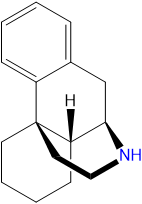Substituted morphinans: Difference between revisions
>Tracer m Added ====Opioid antagonists==== |
>Tracer m Added ====Opioid antagonists==== |
(No difference)
| |
Revision as of 21:00, 26 May 2019

 |
This article is a stub. As such, it may contain incomplete or wrong information. You can help by expanding it. |
Morphinans are a class of chemicals that include compounds with psychoactive effects.
Chemistry
Morphinans are made up of the morphinan molecule with altering functional groups attached on the numbered carbons. Morphinan is comprised of a 1-benzylisoquinoline backbone with two additional ring closures. It features three benzene rings, where two are partially unsaturated, as well as a piperidine ring. It can have various substitutions at R3 and R6, and it is commonly substituted at RN with a methyl group and at R4 and R5 with an ether linkage to form products of varying potency, affinity, efficacy and half-life. It is a very flexible molecule with five chiral centers, which results in a lot of different configurations of the bonds.
Pharmacology
The morphinans are a large chemical class and compounds within it have differing pharmacological effects. Active morphinan derivatives often act upon the NMDA receptor, the μ-opioid receptor and the σ1 and σ2 sigma receptors.
Examples
Morphinans are seen throughout organic chemistry including many analgesic, antitussive and anaesthetic compounds.
Analgesic drugs
- Morphine
- Codeine
- Hydrocodone
- Oxycodone
- Heroin
- Buprenorphine
- Desomorphine
- Dihydrocodeine
- Ethylmorphine
- Hydromorphone
- Oxymorphone
- Thebaine
Dissociative drugs
Opioid antagonists
See also
External links
References
 |
This article does not cite enough references. You can help by adding some. |